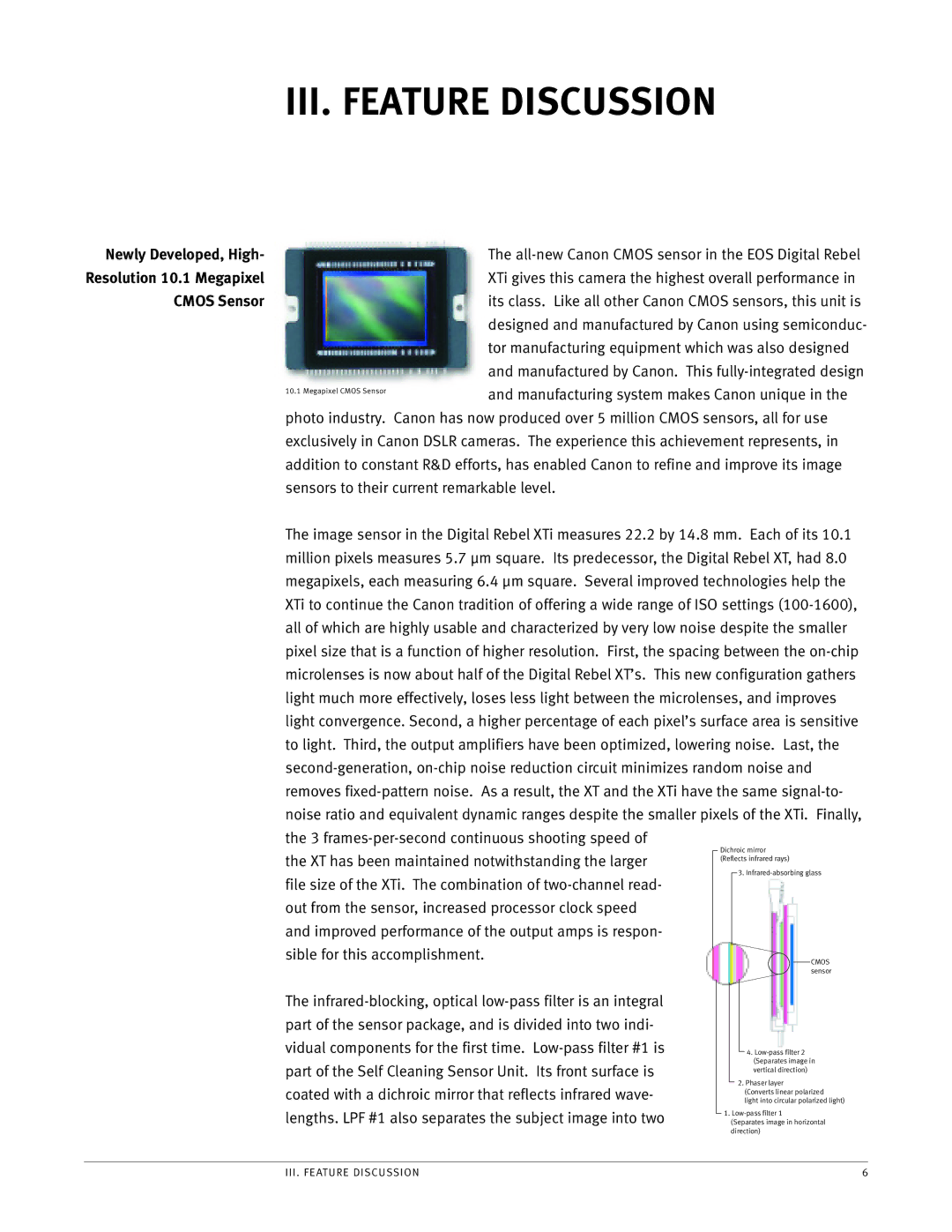Dichroic mirror (Reflects infrared rays)
3. Infrared-absorbing glass
CMOS sensor
4. Low-pass filter 2 (Separates image in vertical direction)
2. Phaser layer (Converts linear polarized
light into circular polarized light)
1. Low-pass filter 1 (Separates image in horizontal direction)
III. FEATURE DISCUSSION
Newly Developed, High- | | The all-new Canon CMOS sensor in the EOS Digital Rebel |
Resolution 10.1 Megapixel | | XTi gives this camera the highest overall performance in |
CMOS Sensor | | its class. Like all other Canon CMOS sensors, this unit is |
| | designed and manufactured by Canon using semiconduc- |
| | tor manufacturing equipment which was also designed |
| | and manufactured by Canon. This fully-integrated design |
| 10.1 Megapixel CMOS Sensor | and manufacturing system makes Canon unique in the |
| |
photo industry. Canon has now produced over 5 million CMOS sensors, all for use exclusively in Canon DSLR cameras. The experience this achievement represents, in addition to constant R&D efforts, has enabled Canon to refine and improve its image sensors to their current remarkable level.
The image sensor in the Digital Rebel XTi measures 22.2 by 14.8 mm. Each of its 10.1 million pixels measures 5.7 µm square. Its predecessor, the Digital Rebel XT, had 8.0 megapixels, each measuring 6.4 µm square. Several improved technologies help the XTi to continue the Canon tradition of offering a wide range of ISO settings (100-1600), all of which are highly usable and characterized by very low noise despite the smaller pixel size that is a function of higher resolution. First, the spacing between the on-chip microlenses is now about half of the Digital Rebel XT’s. This new configuration gathers light much more effectively, loses less light between the microlenses, and improves light convergence. Second, a higher percentage of each pixel’s surface area is sensitive to light. Third, the output amplifiers have been optimized, lowering noise. Last, the second-generation, on-chip noise reduction circuit minimizes random noise and removes fixed-pattern noise. As a result, the XT and the XTi have the same signal-to- noise ratio and equivalent dynamic ranges despite the smaller pixels of the XTi. Finally, the 3 frames-per-second continuous shooting speed of
the XT has been maintained notwithstanding the larger file size of the XTi. The combination of two-channel read- out from the sensor, increased processor clock speed and improved performance of the output amps is respon-
sible for this accomplishment.
The infrared-blocking, optical low-pass filter is an integral part of the sensor package, and is divided into two indi- vidual components for the first time. Low-pass filter #1 is part of the Self Cleaning Sensor Unit. Its front surface is coated with a dichroic mirror that reflects infrared wave- lengths. LPF #1 also separates the subject image into two

